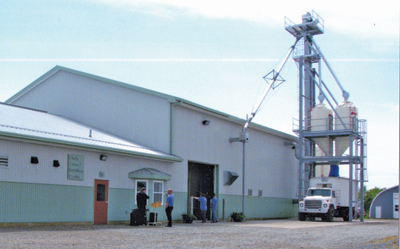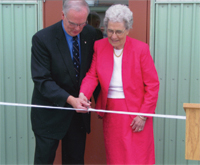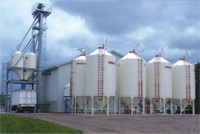
Enhanced Feed Research a Reality
By Dan Woolley
Features Business & Policy Farm BusinessChute Animal Nutrition Centre will allow the APRC to prepare commercial quality feeds for poultry
The Nova Scotia Agricultural College completed the second phase of its
Atlantic Poultry Research Centre in late May with the official opening
of Chute Animal Nutrition Centre.
The Nova Scotia Agricultural College completed the second phase of its Atlantic Poultry Research Centre in late May with the official opening of Chute Animal Nutrition Centre.
The $1.9-million nutrition centre will be able to mix and pelletize commercial quality feeds for all species the NSAC conducts research on: poultry, ruminants, fur-bearers and fish.

|
The NSAC named the centre after Dr. Harold Chute, a Class of 1944 graduate. Born in the Annapolis Valley, he went on to be awarded a doctorate in veterinary medicine from the University of Toronto. He then emigrated to the United States, to Maine, where he earned international renown as a poultry disease control expert.
Dr. Chute also was a noted consultant, researcher, entrepreneur, businessman and philanthropist. The Canadian Foundation of Innovation (CFI), a major financial contributor to the NSAC’s poultry research centre was represented at the second phase official opening by its Nova Scotia board member, Dr. Ross McCurdy who commented, “We wouldn’t be standing here today without the generosity of Dr. Chute and other donors.”
 |
|
| Dr. Bernie MacDonald, co-president of the NSAC (left) helps Mrs. Marion Chute cut the ribbon, officially opening the Chute Animal Nutrition Centre. |
Dr. Chute contributed $190,000 to the nutrition centre’s construction before his death in September 2008, making him the largest private donor to the project.
As an active NSAC alumnus, he played an instrumental role in several fundraising campaigns for the college, which responded in gratitude by presenting him with an honorary degree in 1998, its Distinguished Alumnus Award in 1994 and the Honorary Associate Award in 1976.
NSAC’s co-president, Dr. Bernie MacDonald, saw the opening of the nutrition centre as “a major milestone for NSAC…. the beginning of new and exciting opportunities for our students and staff. Here our students will be able to gain hands-on experience in mixing feeds and developing diets to support the health and nutrition of their livestock. This is very important.”
Animal nutrition professor, Dr. Derek Anderson, saw the Chute centre as presenting the NSAC and the APRC with “a research level capability” in examining commercial feed preparation.
Today’s feed mills have to achieve a high level of biosecurity to reach HACCP standards and the Chute centre, with one – directional flood and exterior delivery bins, can prepare feed with a minimal biosecurity risk, said Anderson.
He observed nutrient materials and preparation are the highest costfactors in poultry production and the nutrition will make cost-effective diets.
Until now, the NSAC and the APRC depended on commercial feed mills in Truro to prepare their many different small-batch research diets, which interrupted their long production runs of commercial feeds. “I am sure they are happy to say goodbye to us,” remarked Anderson.
He thought of the Chute centre as “valuable infrastructure” for training in feed manufacturing and technology. “Never before have we had steam pelleting capabilities on campus.”
The centre will also have the capability to do both large- and small-batch mixing and commercial-style feed pelleting.
 |
|
| Alternative exterior view of the new Chute Animal Nutrition Centre |
McCurdy described the Chute centre as “a real diamond,” stating, the CFI invests in projects like it based on a “rigorous assessment of its merits.”
Major public funding partners for the project included the CFI, acting for the federal government, and the four Atlantic provinces.
Dr. Chute’s widow, Marion, accompanied by several family members, travelled from Maine to Truro, N.S., for the nutrition centre’s official opening.
Dr. Chute was too ill to travel to see the centre under construction; but Mrs. Chute says he was able to monitor its progress as his friend and fellow Class of 1944 graduate, Peter Hamilton, sent him reports, and friends in Bangor, Maine, toured the NSAC campus last summer and took photographs.
Construction of the third and final phase of the APRC project, a hatchery, at NSAC’s nearby Agritech Park is scheduled for completion in 2010.
Print this page